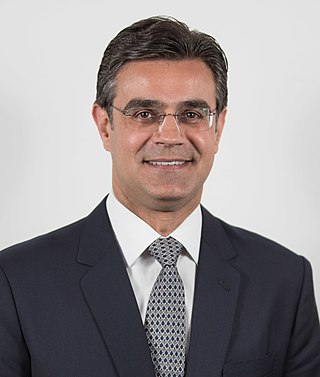
LACNIC is the regional Internet registry for the Latin American and Caribbean regions.

.br is the Internet country code top-level domain (ccTLD) for Brazil. It was administered by the Brazilian Internet Steering Committee until 2005 when it started being administered by Brazilian Network Information Center. A local contact is required for any registration. Registrations of domain names with Portuguese characters are also accepted.

Castilho is a municipality in the state of São Paulo, in Brazil. It has an estimated population of 21,521 in an area of 1,065.318 km2 (411 sq mi), and its elevation is of 378.46 m (1,242 ft) above the sea level.

Sérgio Buarque de Holanda was a Brazilian historian, writer, journalist and sociologist. His greatest achievement was Raízes do Brasil, a landmark of Brazilian sociology, in which he developed the groundbreaking concept of the "cordial man" as the fundamental Brazilian identity. His son, Chico Buarque de Holanda is an accomplished singer-songwriter and novelist and his daughter Miúcha was also a famous singer. Buarque de Holanda was also a member of the Academia Paulista de Letras.
Mario Guimarães Ferri was a professor at the Universidade de São Paulo (USP). He was a research scientist, a lecturer, an editor, an administrator and also an artist. In his scientific work, he was a pioneer ecologist in Brazil. His power of communication linked to a great love of botany and the environment and a deep scientific knowledge made of him an exceptional lecturer. In his books and articles on science he informed the public about ecology and pollution – and in a very simple but precise language he presented the necessary data to understand the importance of the protection of the environment.

Telesp - Telecomunicações de São Paulo S.A. was the telephony operator of the Telebrás system in the Brazilian state of São Paulo, successor to the Companhia Telefônica Brasileira (CTB), later incorporating the Companhia de Telecomunicações do Estado de São Paulo (COTESP) and other smaller companies. It remained active from May 1973 until the privatization process in July 1998, when it was acquired by the Spanish company Telefónica, forming Telefônica Brasil, which in 2012 adopted the Vivo brand for its fixed-line operations.
Maria Isaura Pereira de Queiroz was a Brazilian sociologist.

The Federação das Indústrias do Estado de São Paulo is a Brazilian industry entity. FIESP is affiliated with the National Industry Confederation (CNI).

Boris Fausto was a Brazilian historian, political scientist and writer.

The single largest Japanese diaspora in any city is in São Paulo. In 1958, the census counted 120,000 Japanese in the city and by 1987, there were 326,000 with another 170,000 in the surrounding areas within São Paulo state. As of 2007, the Paulistano Japanese population outnumbered their fellow diaspora in the entirety of Peru, and in all individual American cities.

São Paulo Tramway, Light and Power Company, also known as Light São Paulo or simply Light, was a privately owned utility company operating in São Paulo, Brazil from 1899 until 1981.
Dorath Pinto Uchôa was a Brazilian archaeologist and one of the founders of Brazilian Society of Archaeology. She specialized in the study of prehistoric coastal human settlements with a special emphasis on the study of prehistoric middens in the State of São Paulo, Brazil.

João da Cruz Costa, was a Brazilian philosopher, "first student" of the Philosophy Faculty at Universidade de São Paulo, later becoming full professor at the same institution.

Rodrigo Garcia is a Brazilian lawyer, businessman and politician, affiliated with the Brazilian Social Democracy Party (PSDB). He was state deputy elected for three consecutive legislatures, 1999–2002, 2003–2006 and 2007–2010, and president of the Legislative Assembly of São Paulo from 15 March 2005 to 15 March 2007. He had served as Governor of São Paulo from April to December 2022.
Jorge Emílio Medauar (1918-2003) was a Brazilian poet and writer. He was born in 1918 in the village of Água Preta do Mucambo, currently a municipality in Uruçuca, in the southern region of Bahia. His parents, Emílio Medauar and Maria Zaidan Medauar, were Arab immigrants. When still young, he moved to São Simão, in the interior of São Paulo with his family. His career as a writer, journalist and publicist began in Rio de Janeiro in 1945. Initially, he worked in two magazines linked to the Brazilian Communist Party (PCB), as secretary at Literatura (1946-1948) and editor at Fundamentos (1948-1955).
Nicolau Sevcenko was a Brazilian historian, university professor, columnist, writer, and translator.

Goffredo Carlos da Silva Telles or, as he later adopted Gofredo da Silva Telles Júnior was a Brazilian lawyer, jurist, and university professor.

Renata Pallottini or Renata Monachesi Pallottini was a Brazilian playwright, essayist, poet, theater professor and translator. She was an award-winning author of poetry, plays, essays, fiction, children's literature, theater theory, and television programs who was notable in the Brazilian literary and theater scenes. In a considerable part of her production, it is possible to identify the questioning and the combat against the social values that delimitated the woman's role in society.

Nabil Georges Bonduki is a Brazilian architect, urban planner, university professor, author, and politician. He holds the position of Full Professor of Urban Planning at the University of São Paulo (USP) and serves as a visiting professor at the University of California, Berkeley.














